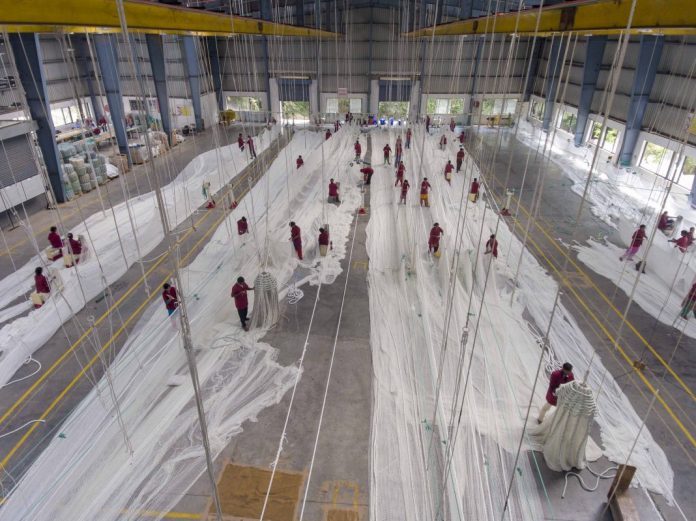“We are developing new products where salmon welfare is the most important parameter”.
“There is one net. The whole room. A 160 grid. Here is a size of the Norwegian aquaculture industry,” said Stig Myran, Garware’s sales representative in Norway, to SalmonBusiness.
The white and fine-masked nets, and a double-digit number of workers, fill the production room at the town of Wai, a couple of hours drive east of Mumbai, India.
“It’s 40m deep. The largest cages in Norway are 200m in circumference, but 160m have gradually become standard. It’s a little less perimeter in the north, or where there are some rough conditions,” said Myran.
Main challenges
“We are developing new products where salmon welfare is the most important parameter,” he added.
- Read more: They have been producing textiles for 3,000 years: How to make nets, moorings and lice nets
The company primarily offers solutions for the aquaculture industry’s main challenges – lice and escapes.
Quality inspectors fine-tune the nets for nonconformities. Seamstresses, with red bindis in their foreheads, sew together the nets that will soon contain farmed salmon. Today they sew for Selstad, Garware’s partner in Måløy, Norway.

Fish farmers’ inventory, and its most important assets, the fish, are kept inside the nets. This integrity is absolutely essential for any aquaculture company. Garware knows that. Therefore, a comprehensive quality and environmental certification is reviewed. Stretch machines are used for testing break strength. Accelerated weather tests determine the lifetime of the product. The result is read on computer screens, the ten year warranty committed.
Some of the products are particularly rigid and reinforced for predators such as seals, sea lions, sharks and tuna. In aquaculture, they are not limited to salmon. On the customer list are also farmers of barramundi, shrimp, tuna, sea bass and so on.

Nytek
“In Norway, the Nytek regulations and NS9415 regulate the production of equipment for farming. Our ropes used for nets and moorings in salmon farming are NS9415 approved and the nets are also produced in accordance with NS9415. Aquastructures are used for certification,” said Stig Myran.
“Washing of nets in the sea and on land, as well as water currents, temperatures and UV effects ensure wear on the net and rope. We have a strict gate quality process that ensures that every step of the process is checked from the raw material inventory to packaging,” he said.

Garware Technical Fiber is launching a new farming range in the new few days where an EU-approved biocide is added to the thread. It is added together with the granules in the extruder in a patented process. This product delays fouling growth on the nets, which is beneficial for both fish health and costs for washing nets in the sea. Compared to the use of treated nets, this product does not give any sedimentation of residues from the anti-growth products under the label. The Aquaculture Stewartship Council (ASC) recognised this product as legally in use on ASC approved facilities.
Do you also produce completely closed cages?
“We can produce some of the material for closed cages, but do not produce the cage itself,” said Myran.

